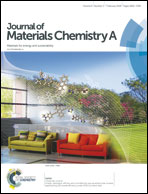Enhanced electron transfer and light absorption on imino polymer capped PdAg nanowire networks for efficient room-temperature dehydrogenation of formic acid†
Abstract
The electronic structure tuning of heterogeneous nanocatalysts is considered as one of the most effective ways of enhancing the catalytic activity of different chemical reactions. Herein, we demonstrate an effective way of tuning the electronic structure of networked PdAg nanowires (NWs) using polyvinylpyrrolidine imine (PVPI) as a new ligand to achieve more efficient hydrogen generation from formic acid (FA) decomposition. The PVPI-capped Pd5Ag5 NWs show the highest activity for the dehydrogenation catalysis of FA with an initial turnover frequency (TOF) of 242 h−1 among all the reported catalysts, and an increased TOF of 312 h−1 under 365 nm light irradiation at room temperature. X-ray photoelectron spectroscopy and Fourier transform infrared spectroscopy studies reveal that there is an interfacial electron transfer from PVPI to the PdAg NW surface, which is the key factor in boosting the dehydrogenation catalysis of FA herein. Density functional theory calculations suggest that the high catalytic activity primarily stems from both electronegative Pd active centers and the imino group (C![[double bond, length as m-dash]](https://www.rsc.org/images/entities/char_e001.gif) N) in PVPI for efficiently deprotonating FA to Pd-formate intermediates and subsequently for promoting the cleavage of C–H. The PVPI-capped Pd5Ag5 NWs are very stable and reusable for FA dehydrogenation catalysis.
N) in PVPI for efficiently deprotonating FA to Pd-formate intermediates and subsequently for promoting the cleavage of C–H. The PVPI-capped Pd5Ag5 NWs are very stable and reusable for FA dehydrogenation catalysis.



 Please wait while we load your content...
Please wait while we load your content...